Development and Analysis of Silver Nitroprusside Nanoparticle-Incorporated Sodium Alginate Films for Banana Browning Prevention
Abstract
1. Introduction
2. Materials and Methods
2.1. Materials
2.2. Synthesis of AgNNPs
2.3. Preparation of SA-AgNNPs Films
2.4. Characterization of AgNNPs, SA Films, and SA-AgNNPs Films
2.5. Well Diffusion Assay of SA-AgNNPs Films
2.6. MIC and MBC Assays of SA-AgNNPs Films
2.7. Anti-Biofilm Assay of SA-AgNNPs Films
2.8. Cytotoxicity Assays
2.9. Hemolysis Assay
2.10. Banana Preservation
2.11. Weight Loss of Bananas during Preservation
2.12. Measurements of Total Sugar Content and Total Bacterial Colonies in Bananas
2.13. Statistical Analyses
3. Results and Discussion
3.1. Characterizations of AgNNPs, SA Films, and SA-AgNNPs Films
3.1.1. TEM and SEM Analysis of AgNNPs, SA Films, and SA-AgNNPs Films
3.1.2. Physical Appearance and Optical Properties of SA Films and SA-AgNNPs Films
3.1.3. XRD and FTIR Analysis of AgNNPs, SA Films, and SA-AgNNPs Films
3.1.4. Zeta Size and Zeta Potential Analysis of AgNNPs and SA-AgNNPs
3.2. Antibacterial Activity of SA-AgNNPs Films
3.2.1. Well Diffusion Assay of SA-AgNNPs Films
3.2.2. MIC and MBC of SA-AgNNPs Films
3.2.3. Anti-Biofilm Assay of SA-AgNNPs Films
3.3. Safety Assessment of AgNNPs, SA Films, and SA-AgNNPs Films
3.3.1. Cytotoxicity Assays of SA-AgNNPs Films
3.3.2. Hemolysis Assays of SA-AgNNPs Films
3.4. Application for Banana Preservation
3.4.1. Changes in Visual Appearance
3.4.2. Changes in Weight Loss
3.4.3. Changes in Total Soluble Sugars
3.4.4. Changes in TBC
4. Conclusions
Supplementary Materials
Author Contributions
Funding
Data Availability Statement
Conflicts of Interest
References
- Kumari, M.; Mahajan, H.; Joshi, R.; Gupta, M. Development and structural characterization of edible films for improving fruit quality. Food Packag. Shelf Life 2017, 12, 42–50. [Google Scholar] [CrossRef]
- Xing, Y.; Li, W.; Wang, Q.; Li, X.; Xu, Q.; Guo, X.; Bi, X.; Liu, X.; Shui, Y.; Lin, H. Antibacterial nanoparticles incorporated in edible coatings and films for the preservation of fruits and vegetables. Molecules 2019, 24, 1695. [Google Scholar] [CrossRef]
- Mohapatra, D.; Mishra, S.; Singh, C.B.; Jayas, D.S. Post-harvest processing of banana: Opportunities and challenges. Food Bioprocess Technol. 2011, 4, 327–339. [Google Scholar] [CrossRef]
- Palomer, X.; Roig-Villanova, I.; Grima-Calvo, D.; Vendrell, M. Effects of nitrous oxide (N2O) treatment on the postharvest ripening of banana fruit. Postharvest Biol. Technol. 2005, 36, 167–175. [Google Scholar] [CrossRef]
- Srivastava, M.K.; Dwivedi, U.N. Delayed ripening of banana fruit by salicylic acid. Plant Sci. 2000, 158, 87–96. [Google Scholar] [CrossRef]
- Jiang, Y.; Joyce, D.C.; Macnish, A.J. Responses of banana fruit to treatment with 1-methylcyclopropene. Plant Growth Regul. 1999, 28, 77–82. [Google Scholar] [CrossRef]
- Madan, R.K.; Levitt, J. A review of toxicity from topical salicylic acid preparations. J. Am. Acad. Dermatol. 2014, 70, 788–792. [Google Scholar] [CrossRef]
- La, D.D.; Nguyen-Tri, P.; Le, K.H.; Nguyen, P.T.; Nguyen, M.D.-B.; Vo, A.T.; Chang, S.W.; Tran, L.D.; Chung, W.J.; Nguyen, D.D. Effects of antibacterial ZnO nanoparticles on the performance of a chitosan/gum arabic edible coating for post-harvest banana preservation. Prog. Org. Coat. 2021, 151, 106057. [Google Scholar] [CrossRef]
- Nguyen, T.T.; Nguyen, T.-T.H.; Pham, B.-T.T.; Van Tran, T.; Bach, L.G.; Thi, P.Q.B.; Thuc, C.H. Development of poly (vinyl alcohol)/agar/maltodextrin coating containing silver nanoparticles for banana (Musa acuminate) preservation. Food Packag. Shelf Life 2021, 29, 100740. [Google Scholar] [CrossRef]
- Pham, B.-T.T.; Tran, T.-D.; Phung, T.K.; Bach, L.G.; Nguyen, D.V.; Nguyen, T.T. Pectin/agarose-based coating functionalized with Piper betel L. extract for enhancing storability of postharvest bananas. Prog. Org. Coat. 2023, 185, 107916. [Google Scholar] [CrossRef]
- Chen, J.; Wu, A.; Yang, M.; Ge, Y.; Pristijono, P.; Li, J.; Xu, B.; Mi, H. Characterization of sodium alginate-based films incorporated with thymol for fresh-cut apple packaging. Food Control 2021, 126, 108063. [Google Scholar] [CrossRef]
- Janik, W.; Nowotarski, M.; Ledniowska, K.; Shyntum, D.Y.; Krukiewicz, K.; Turczyn, R.; Sabura, E.; Furgoł, S.; Kudła, S.; Dudek, G. Modulation of physicochemical properties and antibacterial activity of sodium alginate films through the use of chestnut extract and plasticizers. Sci. Rep. 2023, 13, 11530. [Google Scholar] [CrossRef]
- Tong, W.Y.; Rafiee, A.R.A.; Leong, C.R.; Tan, W.-N.; Dailin, D.J.; Almarhoon, Z.M.; Shelkh, M.; Nawaz, A.; Chuah, L.F. Development of sodium alginate-pectin biodegradable active food packaging film containing cinnamic acid. Chemosphere 2023, 336, 139212. [Google Scholar] [CrossRef]
- Wang, T.; Yi, W.; Zhang, Y.; Wu, H.; Fan, H.; Zhao, J.; Wang, S. Sodium alginate hydrogel containing platelet-rich plasma for wound healing. Colloids Surf. B Biointerfaces 2023, 222, 113096. [Google Scholar]
- Tan, X.; Liu, Y.; Wu, X.; Geng, M.; Teng, F. Layer-by-layer self-assembled liposomes prepared using sodium alginate and chitosan: Insights into vesicle characteristics and physicochemical stability. Food Hydrocoll. 2024, 149, 109606. [Google Scholar] [CrossRef]
- Cruz, A.I.C.; Costa, M.d.C.; Mafra, J.F.; Ferreira, M.A.; Miranda, F.M.; Costa, J.A.; Watanabe, Y.N.; Ribeiro, P.R.; Araújo, F.M.; Evangelista-Barreto, N.S. A sodium alginate bilayer coating incorporated with green propolis extract as a powerful tool to extend Colossoma macropomum fillet shelf-life. Food Chem. 2021, 355, 129610. [Google Scholar] [CrossRef]
- Lade, B.D.; Dhowlaghar, N.; Pillai, S.S.; Patil, B.S. Physicochemical, mechanical, and antibacterial properties of sodium alginate films as carriers of zein emulsion with pelargonic acid and eugenol for active food packing. Food Packag. Shelf Life 2023, 40, 101202. [Google Scholar] [CrossRef]
- Shi, S.; Xu, X.; Ren, Y.; Zhang, H.; Du, X.; Li, H.; Xia, X. Beeswax coating improves the hydrophobicity of sodium alginate/anthocyanin/cellulose nanocrystal indicator film. Food Hydrocoll. 2023, 144, 108930. [Google Scholar]
- Guo, B.; Sun, Y.; Guan, Q.; Luo, Z.; Zhou, L.; Xu, Z.; Han, J.; Qu, D. Fabrication and characterization of sodium alginate/blueberry anthocyanins/hinokitiol loaded ZIF-8 nanoparticles composite films with antibacterial activity for monitoring pork freshness. Food Chem. 2024, 440, 138200. [Google Scholar] [CrossRef]
- Elhadef, K.; Chaari, M.; Akermi, S.; Ennouri, K.; Hlima, H.B.; Fourati, M.; Mtibaa, A.C.; Ennouri, M.; Sarkar, T.; Shariati, M.A.; et al. Gelatin-sodium alginate packaging film with date pits extract: An eco-friendly packaging for extending raw minced beef shelf life. Meat Sci. 2024, 207, 109371. [Google Scholar] [CrossRef]
- Ranjbar, M.; Tabrizzad, M.H.A.; Asadi, G.; Ahari, H. Investigating the microbial properties of sodium alginate/chitosan edible film containing red beetroot anthocyanin extract for smart packaging in chicken fillet as a pH indicator. Heliyon 2023, 9, e18879. [Google Scholar] [CrossRef]
- Qiu, Z.Z.; Chin, K.B. Effect of sodium alginate active film incorporating different lotus rhizome root powders on the physicochemical properties and shelf-life of low-fat model sausages. Food Packag. Shelf Life 2022, 33, 100897. [Google Scholar] [CrossRef]
- Aloui, H.; Deshmukh, A.R.; Khomlaem, C.; Kim, B.S. Novel composite films based on sodium alginate and gallnut extract with enhanced antioxidant, antimicrobial, barrier and mechanical properties. Food Hydrocoll. 2021, 113, 106508. [Google Scholar] [CrossRef]
- Song, Y.; Liu, L.; Shen, H.; You, J.; Luo, Y. Effect of sodium alginate-based edible coating containing different anti-oxidants on quality and shelf life of refrigerated bream (Megalobrama amblycephala). Food Control 2011, 22, 608–615. [Google Scholar] [CrossRef]
- Han, Y.; Yu, M.; Wang, L. Physical and antibacterial properties of sodium alginate/carboxymethyl cellulose films incorporated with cinnamon essential oil. Food Packag. Shelf Life 2018, 15, 35–42. [Google Scholar] [CrossRef]
- Kumar, M.; Bala, R.; Gondil, V.S.; Jain, D.V.S.; Chhibber, S.; Sharma, R.K.; Wangoo, N. Efficient, Green and One Pot Synthesis of Sodium Acetate Functionalized Silver Nanoparticles and Their Potential Application as Food Preservative. BioNanoScience 2017, 7, 521–529. [Google Scholar] [CrossRef]
- Hottinger, D.G.; Beebe, D.S.; Kozhimannil, T.; Prielipp, R.C.; Belani, K.G. Sodium nitroprusside in 2014: A clinical concepts review. J. Anaesthesiol. Clin. Pharmacol. 2014, 30, 462–471. [Google Scholar]
- Rao, B.R.; Kotcherlakota, R.; Nethi, S.K.; Puvvada, N.; Sreedhar, B.; Chaudhuri, A.; Patra, C.R. Ag2[Fe(CN)5NO] nanoparticles exhibit antibacterial activity and wound healing properties. ACS Biomater. Sci. Eng. 2018, 4, 3434–3449. [Google Scholar] [CrossRef]
- Rao, B.R.; Kumar, R.; Haque, S.; Kumar, J.M.; Rao, T.N.; Kothapalli, R.V.; Patra, C.R. Ag2[Fe(CN)5NO]-fabricated hydrophobic cotton as a potential wound healing dressing: An in vivo approach. ACS Appl. Mater. Interfaces 2021, 13, 10689–10704. [Google Scholar] [CrossRef]
- Jin, Y.; Lin, J.; Sathiyaseelan, A.; Zhang, X.; Wang, M.-H. Comparative studies on antibacterial, antibiofilm, antioxidant, and cytotoxicity properties of chemically and Paeonia lactiflora extract-assisted synthesized silver nitroprusside nanoparticles. J. Drug Deliv. Sci. Technol. 2023, 92, 105269. [Google Scholar] [CrossRef]
- Sathiyaseelan, A.; Saravanakumar, K.; Zhang, X.; Naveen, K.V.; Wang, M.-H. Ampicillin-resistant bacterial pathogens targeted chitosan nano-drug delivery system (CS-AMP-P-ZnO) for combinational antibacterial treatment. Int. J. Biol. Macromol. 2023, 237, 124129. [Google Scholar] [CrossRef]
- Júnior, L.M.; Jamróz, E.; de Ávila Gonçalves, S.; da Silva, R.G.; Alves, R.M.V.; Vieira, R.P. Preparation and characterization of sodium alginate films with propolis extract and nano-SiO2. Food Hydrocoll. Health 2022, 2, 100094. [Google Scholar] [CrossRef]
- Muralidharan, V.; Ramesh, S.; Muthukrishnan, L. Facile fabrication of Annona squamosa L. seed extract mediated silver nanoparticles challenged against biofilm forming oral pathogens. Plant Nano Biol. 2023, 3, 100023. [Google Scholar]
- Hsueh, P.-R.; Ko, W.-C.; Wu, J.-J.; Lu, J.-J.; Wang, F.-D.; Wu, H.-Y.; Wu, T.-L.; Teng, L.-J. Consensus statement on the adherence to Clinical and Laboratory Standards Institute (CLSI) Antibacterial Susceptibility Testing Guidelines (CLSI-2010 and CLSI-2010-update) for Enterobacteriaceae in clinical microbiology laboratories in Taiwan. J. Microbiol. Immunol. Infect. 2010, 43, 452–455. [Google Scholar] [CrossRef]
- Ding, Y.; Hu, X.; Piao, Y.; Huang, R.; Xie, L.; Yan, X.; Sun, H.; Li, Y.; Shi, L.; Liu, Y. Lipid Prodrug Nanoassemblies via Dynamic Covalent Boronates. ACS Nano 2023, 17, 6601–6614. [Google Scholar] [CrossRef] [PubMed]
- He, Y.; Shi, F.; Hu, J.; Li, H.; Chen, X.; Yuan, L.; Lu, Y.; Du, W.; Li, R.; Wu, J.; et al. Magnetic graphene oxide nanocomposites induce cytotoxicity in ADSCs via GPX4 regulating ferroptosis. Ecotoxicol. Environ. Saf. 2024, 269, 115745. [Google Scholar] [CrossRef] [PubMed]
- Barma, M.D.; Muthupandiyan, I.; Samuel, S.R.; Amaechi, B.T. Inhibition of Streptococcus mutans, antioxidant property and cytotoxicity of novel nano-zinc oxide varnish. Arch. Oral Biol. 2021, 126, 105132. [Google Scholar] [CrossRef] [PubMed]
- Sathiyaseelan, A.; Zhang, X.; Lin, J.; Wang, M.-H. In situ, synthesis of chitosan fabricated tellurium nanoparticles for improved antimicrobial and anticancer applications. Int. J. Biol. Macromol. 2024, 258, 128778. [Google Scholar] [CrossRef] [PubMed]
- Liu, Q.; Li, B.; Li, Y.; Yang, X.; Wang, S.; Qiao, C.; Wang, N. Cross-linked films based on N-hydrophobic-O-hydrophilic chitosan derivatives: Preparation, properties and application in banana storage. Food Hydrocoll. 2023, 135, 108113. [Google Scholar] [CrossRef]
- Das, S.K.; Vishakha, K.; Das, S.; Ganguli, A. Antibacterial and antibiofilm activities of nanoemulsion coating prepared by using caraway oil and chitosan prolongs the shelf life and quality of bananas. Appl. Food Res. 2023, 3, 100300. [Google Scholar] [CrossRef]
- Sathiyaseelan, A.; Saravanakumar, K.; Mariadoss, A.V.A.; Ramachandran, C.; Hu, X.; Oh, D.-H.; Wang, M.-H. Chitosan-tea tree oil nanoemulsion and calcium chloride tailored edible coating increase the shelf life of fresh cut red bell pepper. Prog. Org. Coat. 2021, 151, 106010. [Google Scholar] [CrossRef]
- Fu, D.; Ding, Y.; Guo, R.; Zhang, J.; Wang, H.; Niu, B.; Yan, H. Polylactic acid/polyvinyl alcohol-quaternary ammonium chitosan double-layer films doped with novel antimicrobial agent CuO@ ZIF-8 NPs for fruit preservation. Int. J. Biol. Macromol. 2022, 195, 538–546. [Google Scholar] [CrossRef]
- Mohammadalinejhad, S.; Almasi, H.; Moradi, M. Immobilization of Echium amoenum anthocyanins into bacterial cellulose film: A novel colorimetric pH indicator for freshness/spoilage monitoring of shrimp. Food Control 2020, 113, 107169. [Google Scholar] [CrossRef]
- Shankar, S.; Teng, X.; Rhim, J.-W. Effects of concentration of ZnO nanoparticles on mechanical, optical, thermal, and antimicrobial properties of gelatin/ZnO nanocomposite films. Korean J. Packag. Sci. Technol 2014, 20, 41–49. [Google Scholar]
- Rahut, S.; Basu, S.S.; Basu, J.K. Surfactant assisted self-assembly of Ag+ containing nanocrystals and their facet dependent photocatalytic activity. CrystEngComm 2019, 21, 23–29. [Google Scholar] [CrossRef]
- Bhatia, S.; Al-Harrasi, A.; Al-Azri, M.S.; Ullah, S.; Bekhit, A.E.-D.A.; Pratap-Singh, A.; Chatli, M.K.; Anwer, K.; Aldawsari, M.F. Preparation and physiochemical characterization of bitter orange oil loaded sodium alginate and casein based edible films. Polymers 2022, 14, 3855. [Google Scholar] [CrossRef]
- Cano, A.; Lartundo-Rojas, L.; Shchukarev, A.; Reguera, E. Contribution to the coordination chemistry of transition metal nitroprussides: A cryo-XPS study. New J. Chem. 2019, 43, 4835–4848. [Google Scholar] [CrossRef]
- Ghalsasi, P.P.; Ghalsasi, P.S.; Muthu, D. Back-bonding signature with high pressure: Raman studies on silver nitroprusside. Inorg. Chem. 2017, 56, 9669–9675. [Google Scholar] [CrossRef]
- Rodríguez-Hernández, J.; Reguera, L.; Lemus-Santana, A.A.; Reguera, E. Silver nitroprusside: Atypical coordination within the metal nitroprussides series. Inorganica Chim. Acta 2015, 428, 51–56. [Google Scholar] [CrossRef]
- Angadi, S.C.; Manjeshwar, L.S.; Aminabhavi, T.M. Novel composite blend microbeads of sodium alginate coated with chitosan for controlled release of amoxicillin. Int. J. Biol. Macromol. 2012, 51, 45–55. [Google Scholar] [CrossRef]
- Zeng, Y.-F.; Chen, Y.-Y.; Deng, Y.-Y.; Zheng, C.; Hong, C.-Z.; Li, Q.-M.; Yang, X.-F.; Pan, L.-H.; Luo, J.-P.; Li, X.-Y.; et al. Preparation and characterization of lotus root starch based bioactive edible film containing quercetin-encapsulated nanoparticle and its effect on grape preservation. Carbohydr. Polym. 2024, 323, 121389. [Google Scholar] [CrossRef]
- Tayyab, M.; Haseeb, M.T.; Alsahli, T.G.; Khaliq, N.U.; Hussain, M.A.; Khan, R.; Nawaz, A.; Iqbal, A.; Alanazi, A.S.; Bukhari, S.N.A. Fabrication and optimization of febuxostat-loaded chitosan nanocarriers for better pharmacokinetics profile. Int. J. Biol. Macromol. 2024, 257, 128448. [Google Scholar] [CrossRef] [PubMed]
- Verma, D.; Desai, M.S.; Kulkarni, N.; Langrana, N. Characterization of surface charge and mechanical properties of chitosan/alginate based biomaterials. Mater. Sci. Eng. C 2011, 31, 1741–1747. [Google Scholar] [CrossRef]
- Azam, A.; Ahmed, A.S.; Oves, M.; Khan, M.S.; Habib, S.S.; Memic, A. Antibacterial activity of metal oxide nanoparticles against Gram-positive and Gram-negative bacteria: A comparative study. Int. J. Nanomed. 2012, 7, 6003–6009. [Google Scholar] [CrossRef]
- Liu, Y.; Zheng, M. Fabrication of BODIPY/polyvinyl alcohol/alkaline lignin antibacterial composite films for food packing. Food Chem. 2023, 427, 136691. [Google Scholar] [CrossRef] [PubMed]
- Suganya, S.; Kumar, M.A.; Haldar, S. Effect of bacterial attachment on permeable membranes aided by extracellular polymeric substances. In Microbial and Natural Macromolecules; Elsevier: Amsterdam, The Netherlands, 2021; pp. 733–749. [Google Scholar]
- Alamdari, A.A.; Hashemkhani, M.; Hendessi, S.; Acar, H.Y.; Unal, U.; Motallebzadeh, A. A comprehensive study of microstructure, mechanical behavior, biocorrosion, and cytotoxicity of RF-PVD deposited Ti1.5ZrTa0.5Nb0.5X0.5 (X: Hf, Mo, and W) refractory high-entropy alloy films on 316L. Intermetallics 2023, 162, 108003. [Google Scholar]
- Kubyshkin, A.; Chegodar, D.; Katsev, A.; Petrosyan, A.; Krivorutchenko, Y.; Postnikova, O. Antibacterial effects of silver nanoparticles stabilized in solution by sodium alginate. Biochem. Mol. Biol. J. 2016, 2, 108003. [Google Scholar] [CrossRef]
- Yan, P.; Lan, W.; Xie, J. Modification on sodium alginate for food preservation: A review. Trends Food Sci. Technol. 2023, 143, 104217. [Google Scholar] [CrossRef]
- Sathiyaseelan, A.; Zhang, X.; Wang, M.-H. Biosynthesis of gallic acid fabricated tellurium nanoparticles (GA-Te NPs) for enhanced antibacterial, antioxidant, and cytotoxicity applications. Environ. Res. 2024, 240, 117461. [Google Scholar] [CrossRef]
- Maqbool, M.; Ali, A.; Alderson, P.G.; Zahid, N.; Siddiqui, Y. Effect of a novel edible composite coating based on gum arabic and chitosan on biochemical and physiological responses of banana fruits during cold storage. J. Agric. Food Chem. 2011, 59, 5474–5482. [Google Scholar] [CrossRef]
- Yahia, E.M.; Carrillo-Lopez, A. Postharvest Physiology and Biochemistry of Fruits and Vegetables; Woodhead publishing: Sawston, UK, 2018. [Google Scholar]
- Bai, J.; Alleyne, V.; Hagenmaier, R.D.; Mattheis, J.P.; Baldwin, E.A. Formulation of zein coatings for apples (Malus domestica Borkh). Postharvest Biol. Technol. 2003, 28, 259–268. [Google Scholar] [CrossRef]
- Baldwin, E.; Burns, J.; Kazokas, W.; Brecht, J.; Hagenmaier, R.; Bender, R.; Pesis, E. Effect of two edible coatings with different permeability characteristics on mango (Mangifera indica L.) ripening during storage. Postharvest Biol. Technol. 1999, 17, 215–226. [Google Scholar] [CrossRef]
- Pinzon, M.I.; Sanchez, L.T.; Garcia, O.R.; Gutierrez, R.; Luna, J.C.; Villa, C.C. Increasing shelf life of strawberries (Fragaria ssp.) by using a banana starch-chitosan-Aloe vera gel composite edible coating. Int. J. Food Sci. Technol. 2020, 55, 92–98. [Google Scholar] [CrossRef]
- Ni, Y.; Nie, H.; Wang, J.; Lin, J.; Wang, Q.; Sun, J.; Zhang, W.; Wang, J. Enhanced functional properties of chitosan films incorporated with curcumin-loaded hollow graphitic carbon nitride nanoparticles for bananas preservation. Food Chem. 2022, 366, 130539. [Google Scholar] [CrossRef] [PubMed]
- Veerapandi, G.; Sekar, C. Investigation of glucose concentration in banana as a function of ripening time using Ni-Ca2CuO3 based electrochemical sensor. J. Food Compos. Anal. 2024, 126, 105888. [Google Scholar] [CrossRef]
- Zewter, A.; Woldetsadik, K.; Workneh, T. Effect of 1-methylcyclopropene, potassium permanganate and packaging on quality of banana. Afr. J. Agric. Res. 2012, 7, 2425–2437. [Google Scholar] [CrossRef]
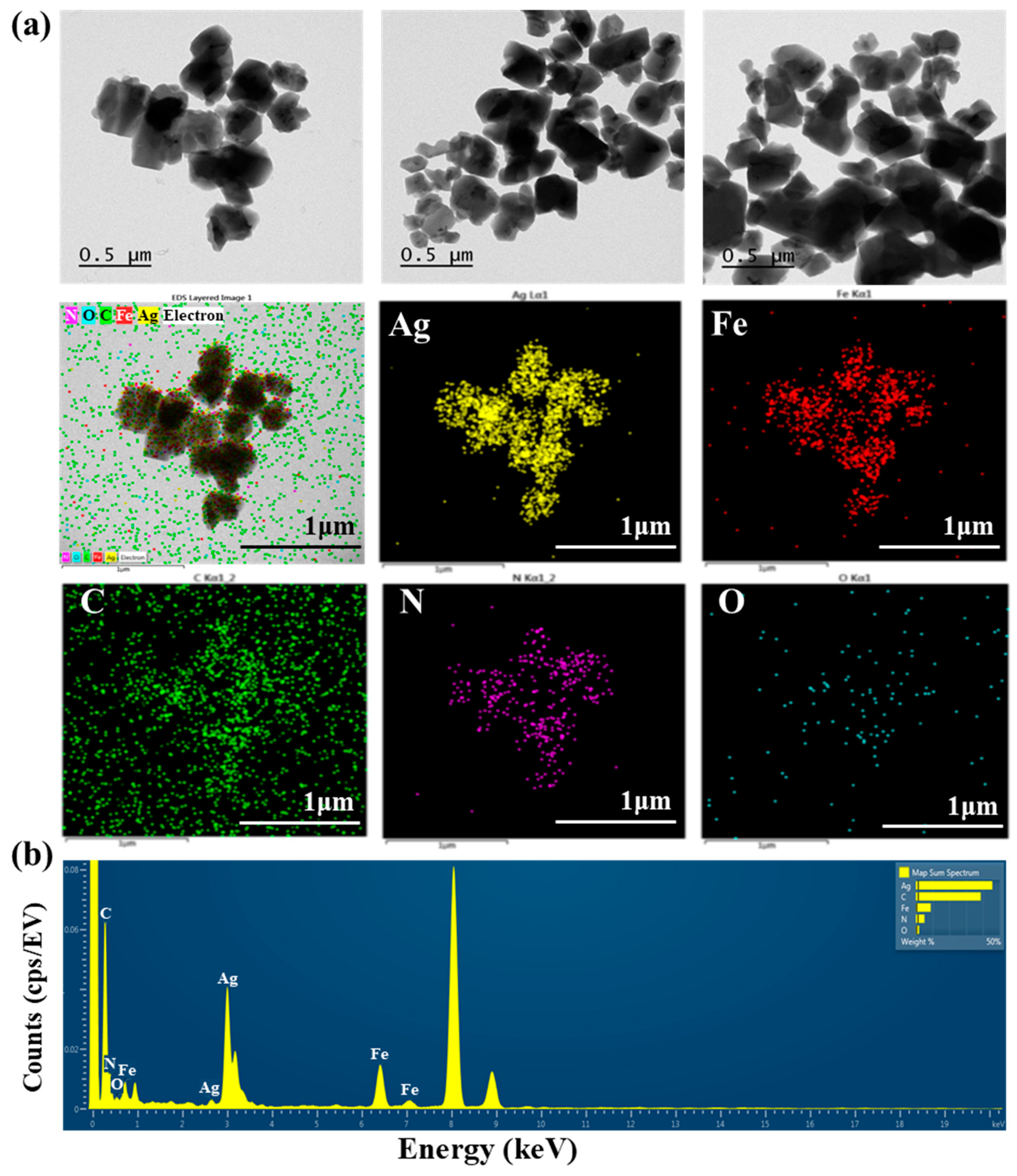


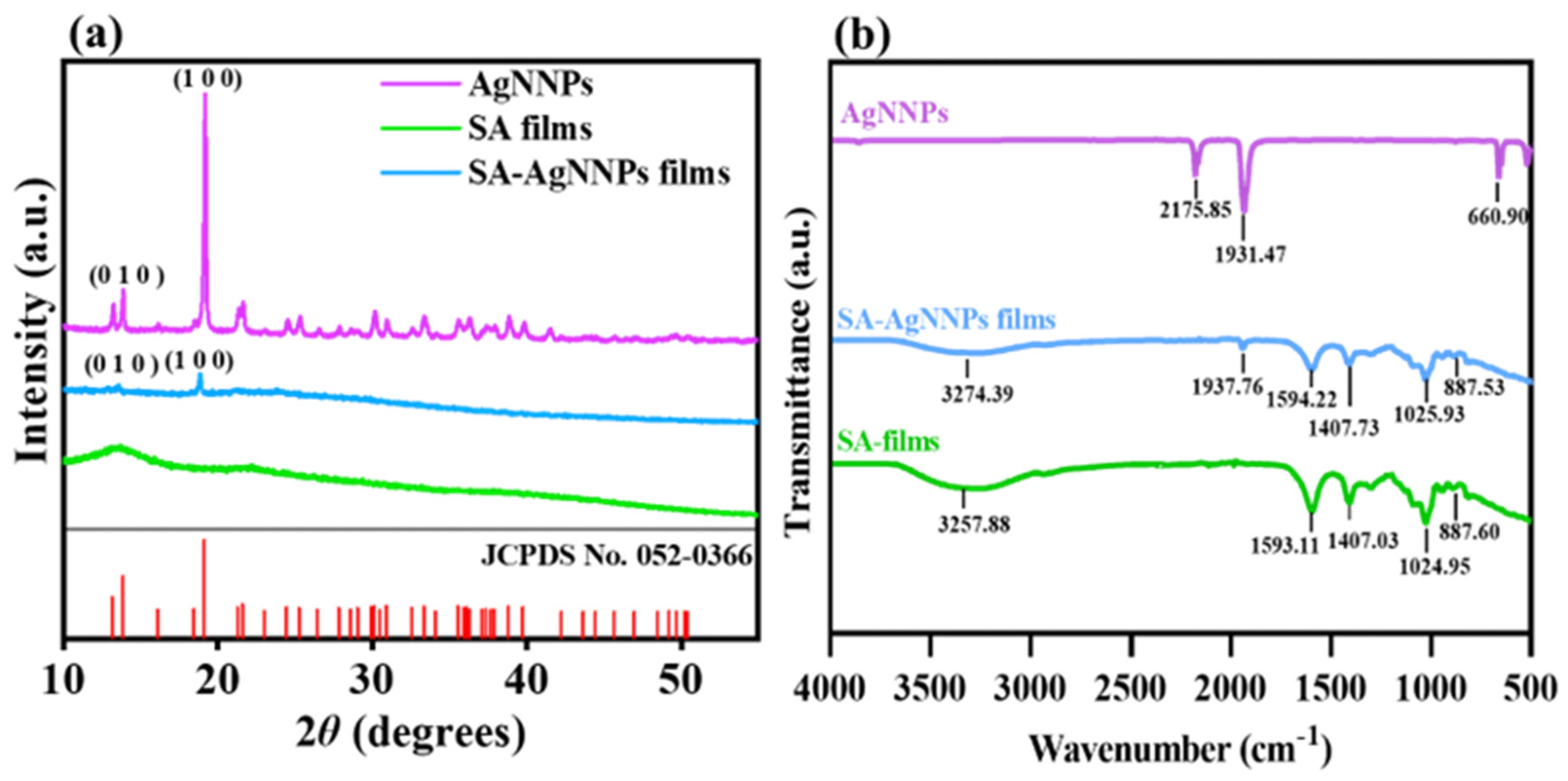
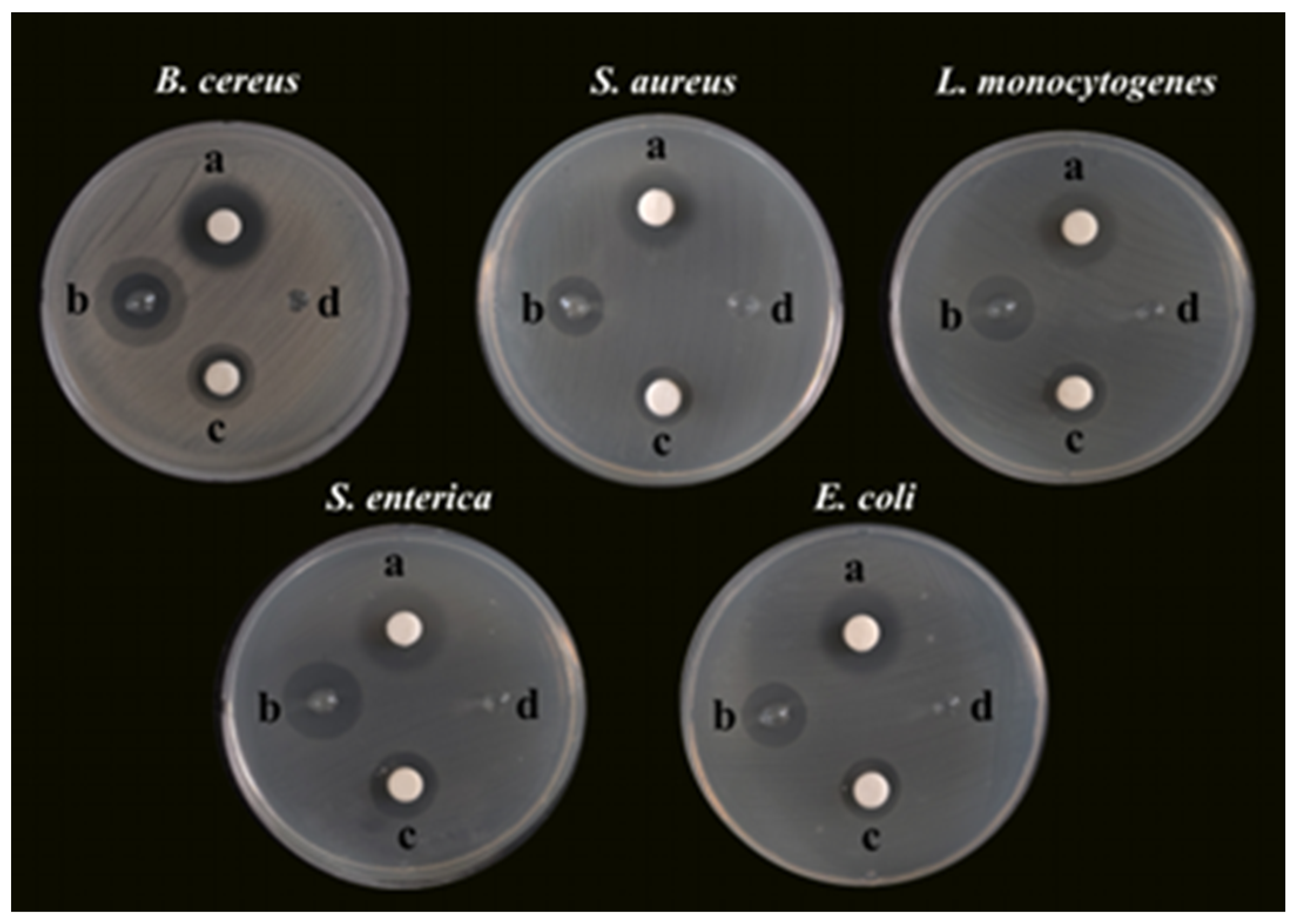
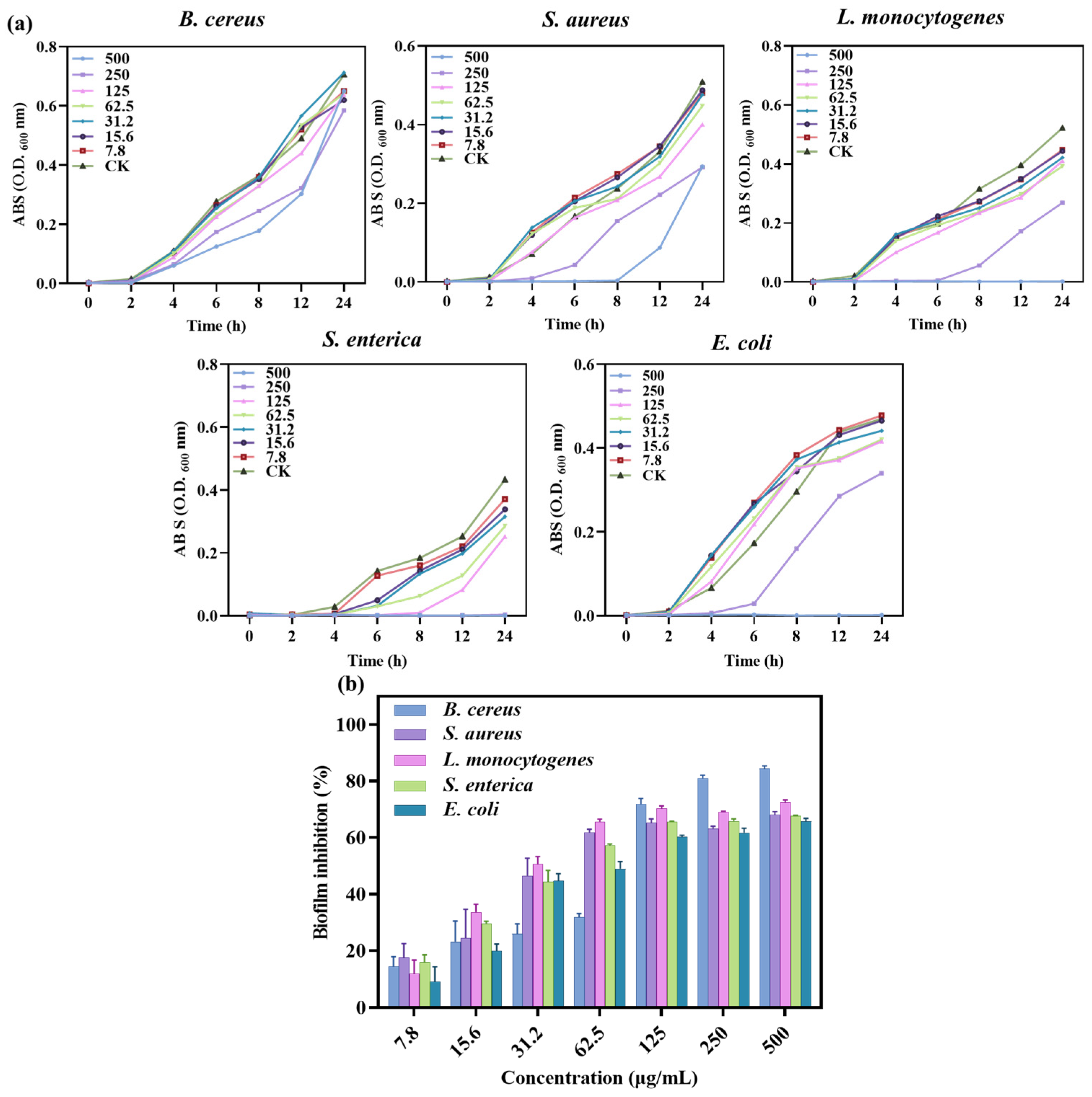
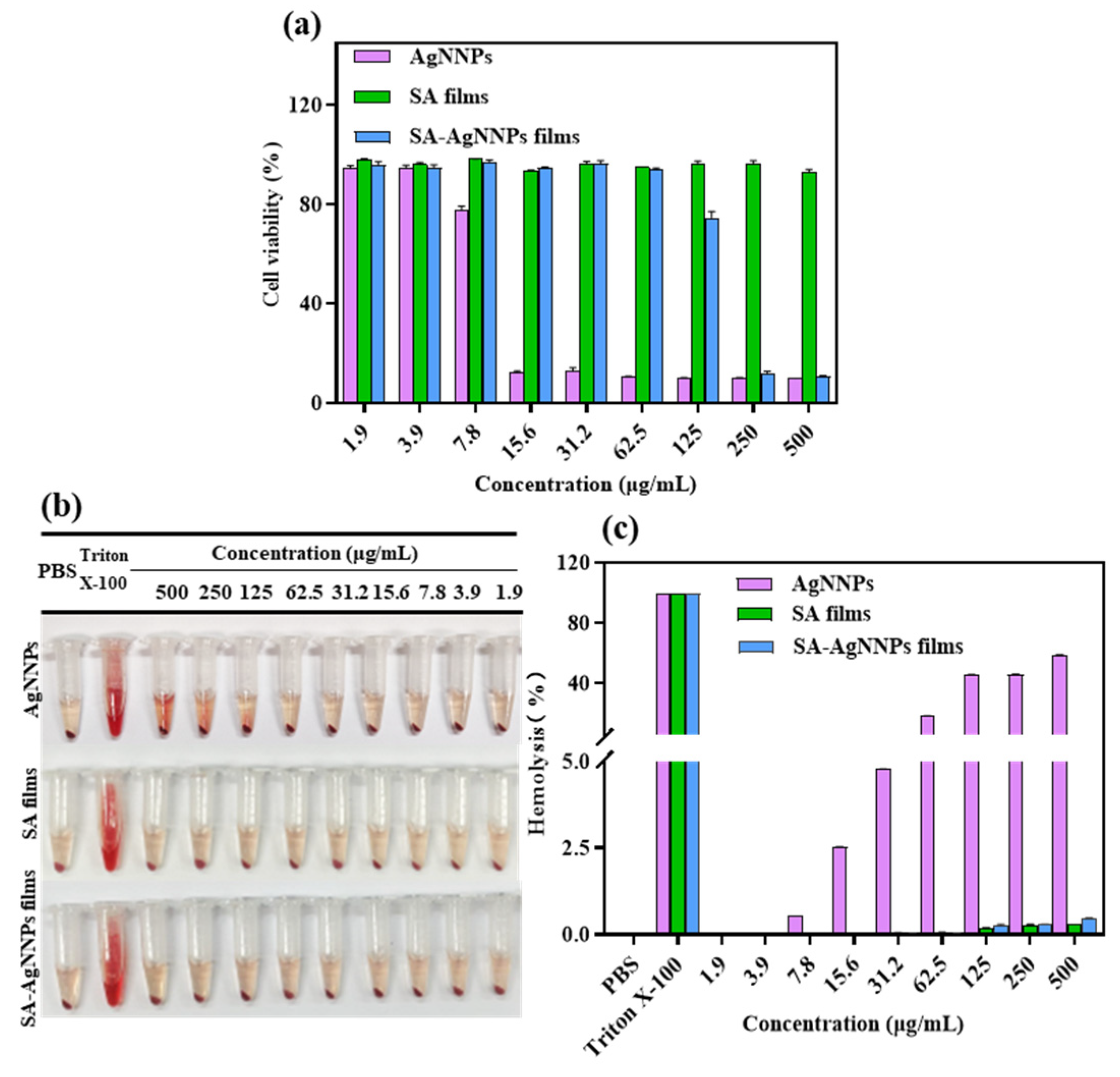
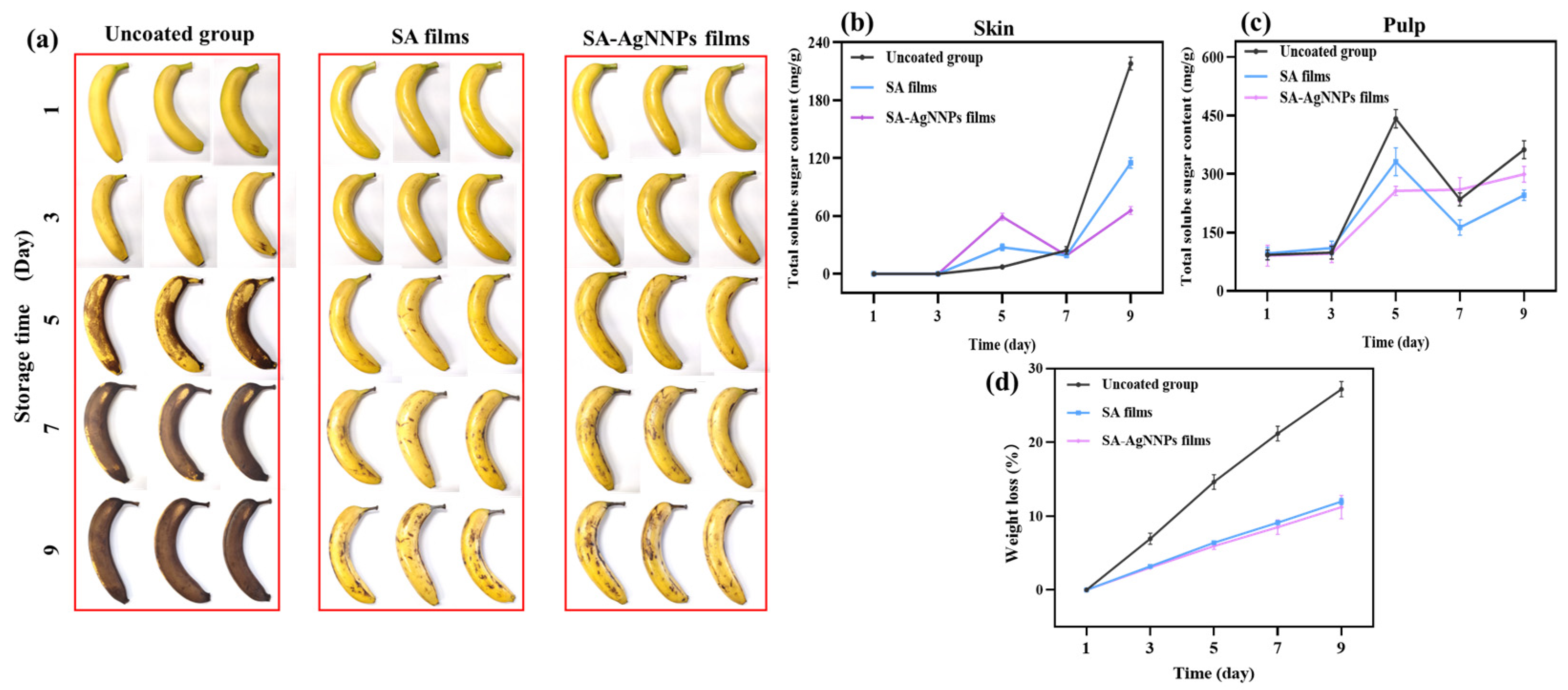
| Sample | Size (d. nm) | Zeta Potential (mV) | PDI |
|---|---|---|---|
| AgNNPs | 541.43 ± 15.19 | −26.97 ± 0.21 | 0.368 ± 0.03 |
| SA-AgNNPs | 365.60 ± 30.75 | −58.40 ± 2.36 | 0.471 ± 0.16 |
| Bacterial Strain | Zone of Inhibition (mm) | |||
|---|---|---|---|---|
| AgNNPs (50 μg) | SA Films (6 mm) | SA-AgNNPs Films (6 mm) | TCH (50 μg) | |
| B. cereus | 12.67 ± 0.29 c | 0 d | 14.50 ± 0.5 b | 20.67 ± 0.58 a |
| S. aureus | 13.33 ± 0.58 c | 0 d | 14.67 ± 0.58 b | 17.67 ± 0.58 a |
| L. monocytogenes | 16.33 ± 0.29 b | 0 c | 16.83 ± 0.29 b | 17.67 ± 0.58 a |
| S. enterica | 16.33 ± 0.58 c | 0 d | 19.76 ± 0.58 b | 21 ± 0 a |
| E. coli | 14.83 ± 0.29 b | 0 c | 15.67 ± 0.58 b | 19 ± 1 a |
| MIC/MBC (µg/mL) | |||||
|---|---|---|---|---|---|
| SA-AgNNPs films | B. cereus | S. aureus | L. monocytogenes | S. enterica | E. coli |
| >500 | >500 | 500 | 250 | 500 | |
| Factors | Treatments | Storage Intervals (Days)/ Storage Intervals (Days)/TBC (CFU/g) | |||||
|---|---|---|---|---|---|---|---|
| 1 | 3 | 5 | 7 | 9 | |||
| TBC | Skin | Uncoated group | 2 × 102 | 2.3 × 103 | 2 × 103 | 1.5 × 105 | 8.96 × 105 |
| SA films | 2.5 × 102 | 1.7 × 103 | 1.8 × 103 | 3.6 × 104 | 1.09 × 105 | ||
| SA-AgNNPs films | 1.3 × 102 | 9.2 × 102 | 8.9 × 102 | 5.4 × 102 | 1.13 × 103 | ||
| Pulp | Uncoated group | 0 | 0 | 3.3 × 102 | 5 × 102 | 3 × 103 | |
| SA films | 0 | 0 | 16 | 100 | 1.64 × 102 | ||
| SA-AgNNPs films | 0 | 0 | 10 | 50 | 51 | ||
Disclaimer/Publisher’s Note: The statements, opinions and data contained in all publications are solely those of the individual author(s) and contributor(s) and not of MDPI and/or the editor(s). MDPI and/or the editor(s) disclaim responsibility for any injury to people or property resulting from any ideas, methods, instructions or products referred to in the content. |
© 2024 by the authors. Licensee MDPI, Basel, Switzerland. This article is an open access article distributed under the terms and conditions of the Creative Commons Attribution (CC BY) license (https://creativecommons.org/licenses/by/4.0/).
Share and Cite
Zhang, L.; Sathiyaseelan, A.; Zhang, X.; Lu, Y.; Wang, M.-H. Development and Analysis of Silver Nitroprusside Nanoparticle-Incorporated Sodium Alginate Films for Banana Browning Prevention. Nanomaterials 2024, 14, 292. https://doi.org/10.3390/nano14030292
Zhang L, Sathiyaseelan A, Zhang X, Lu Y, Wang M-H. Development and Analysis of Silver Nitroprusside Nanoparticle-Incorporated Sodium Alginate Films for Banana Browning Prevention. Nanomaterials. 2024; 14(3):292. https://doi.org/10.3390/nano14030292
Chicago/Turabian StyleZhang, Lina, Anbazhagan Sathiyaseelan, Xin Zhang, Yuting Lu, and Myeong-Hyeon Wang. 2024. "Development and Analysis of Silver Nitroprusside Nanoparticle-Incorporated Sodium Alginate Films for Banana Browning Prevention" Nanomaterials 14, no. 3: 292. https://doi.org/10.3390/nano14030292
APA StyleZhang, L., Sathiyaseelan, A., Zhang, X., Lu, Y., & Wang, M.-H. (2024). Development and Analysis of Silver Nitroprusside Nanoparticle-Incorporated Sodium Alginate Films for Banana Browning Prevention. Nanomaterials, 14(3), 292. https://doi.org/10.3390/nano14030292







